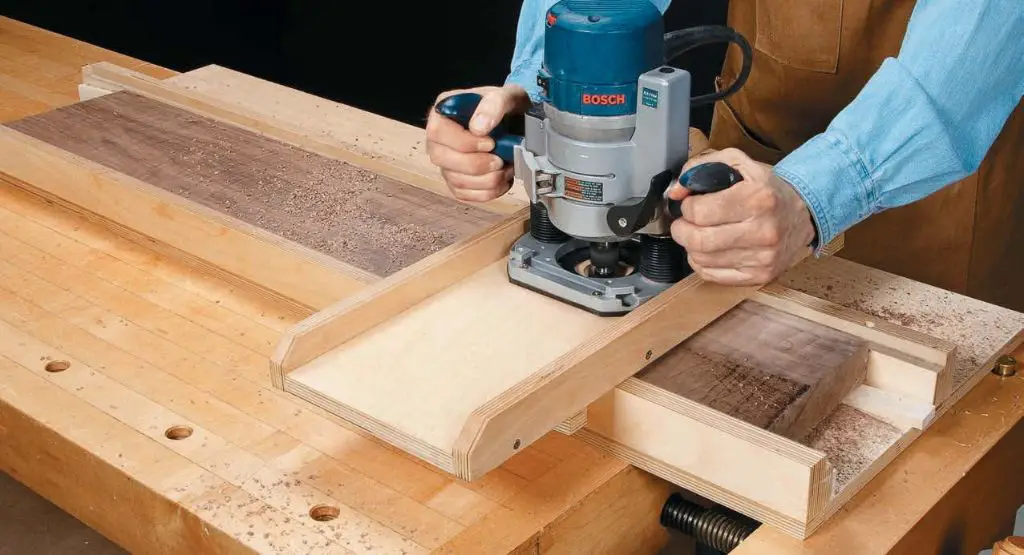Using a router as a planer is possible in some situations, but it’s not recommended as the ideal tool for planing wood. Routers and planers are designed for different purposes and have key differences that make routers less than ideal for planing large surfaces. However, with the right technique and setup, a router can be used for some basic planing in a pinch.
Page Contents
Key Differences Between Routers and Planers
Cutting Mechanism
Planers have straight knives that span the width of the planing surface for even, consistent cuts. Routers use a rotating bit that makes a localized cut based on the bit size and profile. For planing, you need an even cut across a large surface, which a single router bit cannot provide.
Depth of Cut
Planers are designed for deeper cuts of 1/16″ or more per pass. Router bits have a limited depth of cut capacity, usually 1/4″ to 3/8″ max. Removing thicker wood blanks efficiently requires the deeper cuts of a planer.
Workpiece Handling
With a planer, the workpiece remains stationary while the cutterhead moves across it. With a router, the workpiece must be moved manually across the spinning bit. Planing by moving a workpiece across a router risks uneven cuts and kickback.
Dust Collection
Planers have built-in dust ports and collection systems. Routers generate a lot of chips and dust that must be manually collected or vacuumed. Planing leaves a lot of debris, so a planer’s collection system is advantageous.
When a Router Can Work for Planing
Here are some situations where using a router for planing may work:
- Smoothing and light surfacing of thin boards and veneers
- Planing an edge or end grain
- Trimming laminates and edging materials
- Surfacing small or hard-to-plane materials
A router can remove some material and smooth surfaces, but has limited capacity for thicknessing lumber. The ideal router planing setup:
- Use a straight bit large enough to span the workpiece for even cuts
- Adjust bit height precisely for light passes under 1/8″
- Secure workpiece and move router smoothly across surface
- Use a router table or sliding jig for best control
Reasons a Router is Less Than Ideal for Planing
Inconsistent Cuts
It’s extremely difficult to move a handheld or fixed router perfectly evenly across a workpiece manually. This can result in varying cut depths and uneven surfaces.
Tear-Out
Router bits can tear splinters on the exits of cuts, especially in wood with alternating grain patterns. A planer knife makes a shearing cut that minimizes tear-out.
Limitations on Workpiece Size
The small cutters on a router restrict the maximum workpiece width and length that can be machined. Planers can surface boards up to 12-15 inches wide or more.
Slower Process
Light passes with a router to reduce tear-out means it takes longer to remove material. A planer quickly hogs off wood with its heavy cuts.
More Equipment Needed
Using a router table or jig is advised for planing. This requires purchasing more equipment than just buying a planer.
Advantages of an Electric Hand Planer vs. Router
While still limited compared to a stationary planer, a handheld power planer provides some advantages over a router for portable planing:
- Bottom plate spans workpiece for even cuts
- Designed for deeper cuts up to 1/8″ depth
- Planing shoe helps glide across surfaces
- Less prone to tear-out
- Dust chute captures debris
If you only need to trim door edges or plane surfaces occasionally, a hand planer can accomplish similar tasks with better results than trying to use a router freehand.
Conclusion
Routers lack the design features and capabilities that make planers the ideal tool for surfacing and thicknessing lumber. The inconsistencies of using a router for planing wide surfaces could result in wavy edges and uneven boards. In a pinch, a router can do light planing on thin stock but works best for small-scale planing of edges and ends. For serious wood surfacing, a proper planer or thickness planer is highly recommended over makeshift alternatives. Investing in the correct woodworking tools saves time and headaches on the long run.

